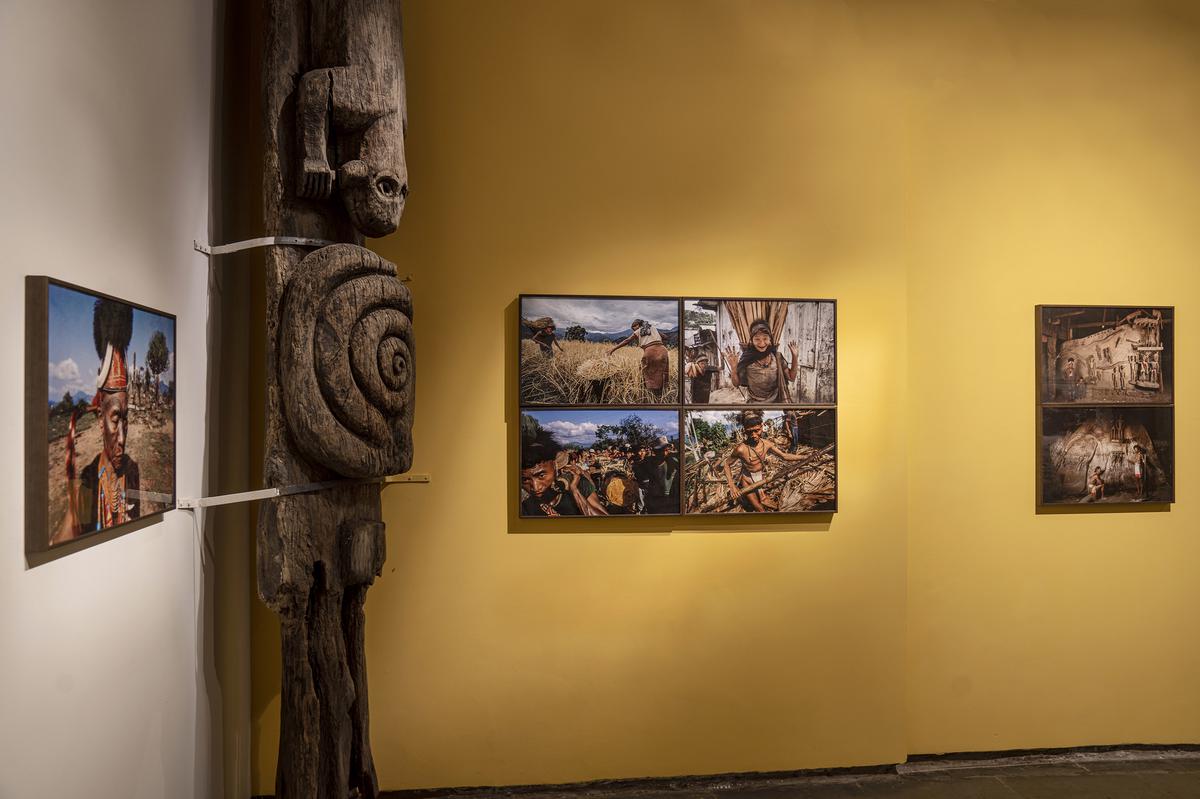The Naga people in photographer Pablo Bartholomew’s stunning images are as exotic as they are real
The Naga people in photographer Pablo Bartholomew’s stunning images are as exotic as they are real
To the unsuspecting eye, five little brass ‘faces’ fashioned into a pendant, held together with colourful beads and strings, would probably be just a fascinating necklace. But photographer Pablo Bartholomew says that those brass faces might represent the number of human heads taken by the Naga warrior who wears the necklace. Bartholomew knows what he is talking about — for over 10 years, he has journeyed deep into Naga territory, often alone, to learn more about their lives and culture.
The photographs he took there between 1989 and 2000 have been brought together in the ongoing exhibition The Nagas, presented by Nine Fish Art Gallery & Dot Line Space in Byculla, Mumbai. Interspersed with the photographs are Naga artefacts from the Great Eastern Home collection of Anurag Kanoria, founder of Nine Fish Gallery. The large wooden sculptures, furniture and ceremonial jewellery (like the necklace) add to the show’s immersiveness.

Village elders of Lungwa village in Mon district, Nagaland, beat the new log drum in frenzy after its installation
| Photo Credit: Pablo Bartholomew/Nephotograph
The term ‘Nagas’ is used to describe the 30-plus tribes who live along the Patkai mountain range, which spills over several geopolitical boundaries. Despite the umbrella term, the Nagas are a diverse people speaking over 60 dialects. The broad Naga identity typifies a proud people, who continue to hold on to their own constitution and flag.
Braving dangers
Spurred on by the stories he had heard as a young boy from his father, the art critic and photographer Richard Bartholomew, Pablo took time off from his career as a photojournalist in the 1990s to document the many living and dying traditions of the Nagas. Travelling in his modified jeep, which would serve as mobile studio, generator van and equipment carrier, Bartholomew braved the dangers not just of unknown terrains, wild animals and secretive tribes, but also the constant low-level war-like situation between Naga insurrectionists and Indian armed forces.

An installation at the exhibition
| Photo Credit: PABLO BARTHOLOMEW
He recalls one such hazardous journey he made to photograph the Tangkhul Nagas in their spectacular lion headdresses, which are adorned with hornbill feathers, a brass dish and human hair, with a jaw-piece made of wood embedded with red and white seeds. Worn specifically by men of the Northern Tangkhul tribe of India and Myanmar, they symbolise male courage, strength and virility.
Front-row view
“To make this set of images, I had to drive to a remote border village without a proper road. The drive was all downhill. I had chosen to drive late evening to avoid detection by local authorities and security forces because otherwise I would have needed multiple permissions. Driving in the dark, following the illegal logging truck tracks, I could not see much of the landscape, only what showed in the headlights. When I finally found the village, which had no electricity, the villagers were shocked to see me alone in my vehicle. No outsider had ever dared to venture into their village before. They gave me food and shelter for the night. I explained to them what I wanted to photograph and with their cooperation the next morning, made the images I wanted. I then made the return journey uphill, back to the Imphal-Jessami-Kohima Road, which led me to another adventure — a story for another day.”
Resilient beauty
Bartholomew, a Padma Shri and l’Ordre des Arts et des Lettres awardee, is possibly one of the few outsiders to have witnessed certain Naga cultural practices, many of which have now been outlawed. One such is headhunting which, though banned by the British, symbolised a certain martial power and virility that still define the Naga tribes. Through the photographs, one gets a front-row view of amazing sights like a hut full of human skulls, a mock-battle ritual called mangpa, the ceremonial installation of log drums that occurs only once in 30-50 years, or the raising of a megalith.
Amid the extravagant displays of hypermasculinity, Bartholomew’s images of Naga women in their everyday lives stand out, as they tend to their children, farm or domestic chores or enjoy a few rare moments to themselves. Although, as anthropologist Dolly Kikon points out, the concept of the “empowered Naga woman” is a myth, Naga society being essentially patriarchal, the women in the photographs radiate a resilient beauty.
From the nature-inspired homes of the Nagas to their warrior rituals; from their music, dance and sculpture to their headhunting practice; from their elaborate costumes and jewellery to their rigid social hierarchies, the exhibition is a veritable crash course in Naga anthropology. The photos are accompanied by detailed captions and a video, although just the visual takeaway is also incredibly rich.
ON SHOW: The Nagas, Nine Fish Art Gallery, Byculla, Mumbai, till April 10.
The author is a culture writer and an Interfaith Studies scholar.
Stay connected with us on social media platform for instant update click here to join our Twitter, & Facebook
We are now on Telegram. Click here to join our channel (@TechiUpdate) and stay updated with the latest Technology headlines.
For all the latest Entertainment News Click Here
For the latest news and updates, follow us on Google News.
